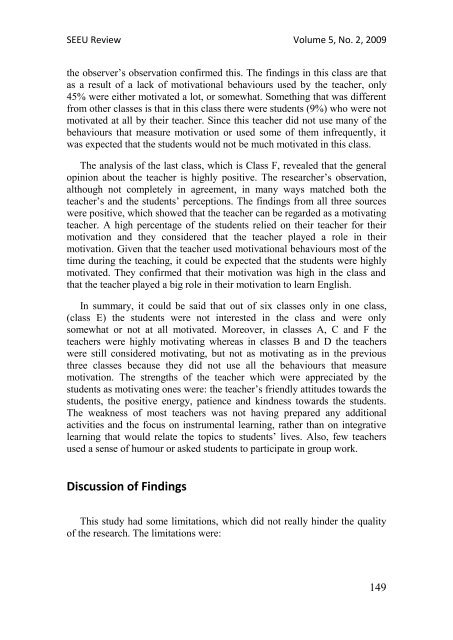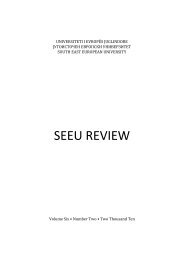SEEU Review vol. 5 Nr. 2 (pdf) - South East European University
SEEU Review vol. 5 Nr. 2 (pdf) - South East European University
SEEU Review vol. 5 Nr. 2 (pdf) - South East European University
Create successful ePaper yourself
Turn your PDF publications into a flip-book with our unique Google optimized e-Paper software.
<strong>SEEU</strong> <strong>Review</strong> Volume 5, No. 2, 2009<br />
the observer’s observation confirmed this. The findings in this class are that<br />
as a result of a lack of motivational behaviours used by the teacher, only<br />
45% were either motivated a lot, or somewhat. Something that was different<br />
from other classes is that in this class there were students (9%) who were not<br />
motivated at all by their teacher. Since this teacher did not use many of the<br />
behaviours that measure motivation or used some of them infrequently, it<br />
was expected that the students would not be much motivated in this class.<br />
The analysis of the last class, which is Class F, revealed that the general<br />
opinion about the teacher is highly positive. The researcher’s observation,<br />
although not completely in agreement, in many ways matched both the<br />
teacher’s and the students’ perceptions. The findings from all three sources<br />
were positive, which showed that the teacher can be regarded as a motivating<br />
teacher. A high percentage of the students relied on their teacher for their<br />
motivation and they considered that the teacher played a role in their<br />
motivation. Given that the teacher used motivational behaviours most of the<br />
time during the teaching, it could be expected that the students were highly<br />
motivated. They confirmed that their motivation was high in the class and<br />
that the teacher played a big role in their motivation to learn English.<br />
In summary, it could be said that out of six classes only in one class,<br />
(class E) the students were not interested in the class and were only<br />
somewhat or not at all motivated. Moreover, in classes A, C and F the<br />
teachers were highly motivating whereas in classes B and D the teachers<br />
were still considered motivating, but not as motivating as in the previous<br />
three classes because they did not use all the behaviours that measure<br />
motivation. The strengths of the teacher which were appreciated by the<br />
students as motivating ones were: the teacher’s friendly attitudes towards the<br />
students, the positive energy, patience and kindness towards the students.<br />
The weakness of most teachers was not having prepared any additional<br />
activities and the focus on instrumental learning, rather than on integrative<br />
learning that would relate the topics to students’ lives. Also, few teachers<br />
used a sense of humour or asked students to participate in group work.<br />
Discussion of Findings<br />
This study had some limitations, which did not really hinder the quality<br />
of the research. The limitations were:<br />
149

















